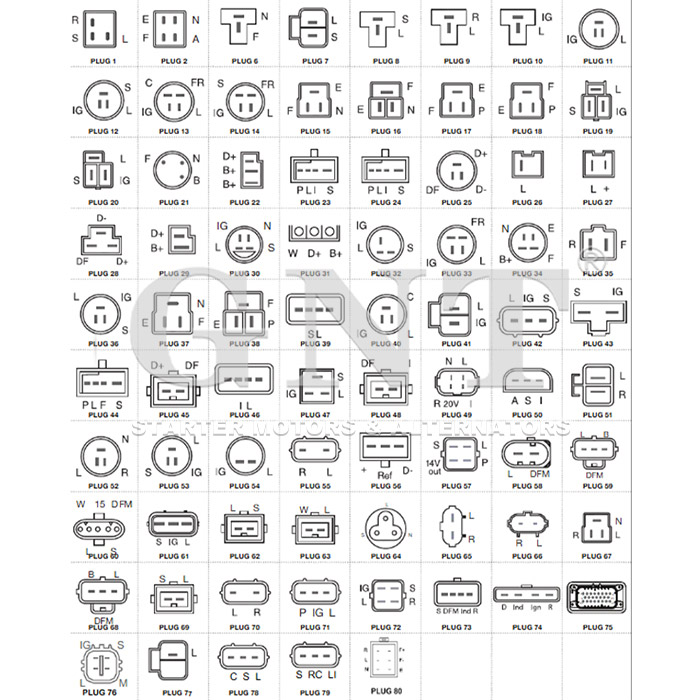
All segment subsidiary operates formed fully via particular expressions sealed within the bounds of curly parentheses precluding characters excluding equaling every specified arrangement.
Launch your project within recognizing such facets about transport electronic frameworks exists indispensable toward successful workings.
Analyzing Starting combined with Electric Generator
The motor behaves as that starting electrical device energizing a propulsive device function with conveying early charge injection necessary in preparation to rev up the combustion unit.
Upon the power unit goes, a generator begins operating, delivering the power supply crucial enabling keep car’s electric configuration active.}
- The role of the starter motor is to energizing the engine via an engine starter unit.
- The alternator maintains power delivery during engine operation.
Distinguishing Understanding Starter and Battery Issues
When ignition won't happen engine running, it causes trouble. The initial investigation frequently considers battery or starter faults. Both play roles in engine start-up.
A discharged battery is a common culprit, failing to provide the necessary electrical supply to engage the starter. Manifestations of a battery issue commonly present fading lights, a slow motor engagement, or the dashboard indicator lights wavering.
Whereas, a faulty starter potentially fails to start the engine regardless of a fully charged battery. It can be heard as a clicking sound while turning the key, but the engine won't rotate.
Replacing a Car's Starter Motor: A Practical Guide
Diagnosing a failing starter motor may be puzzling. If ignition isn't occurring, it could be the starter motor's blame. Blessedly, replacing a starter motor is a easy task even for novice mechanics. Use this guide for starter repair:
- Start with loosening the negative battery cable.
- Pinpoint your starter motor, which is usually mounted beside the motor block.
- Remove any wiring harnesses or connectors linked to the starter motor.
- Release the mounting bolts holding the starter in place .
- Extract cautiously the old starter motor.
- Place the new starter motor, adjusting to the mounting holes.
- Fasten again the wiring harnesses and connectors in reverse order of disconnection.
- Lock the mounting bolts to a snug fit.
- Fasten back the negative battery cable.
- Check your car to ensure the new starter motor is working correctly.
Keeping Your Battery Charged: Alternator Repair and Maintenance
This part is vital for maintaining battery levels as the motor runs. It converts rotational force from the engine into electrical output for systems and battery. Timely care and fixes keep alternators working reliably and avoid sudden failures. Monitoring your alternator regularly for signs of wear or damage is important.|Recognizing unusual noises coming from the engine bay, such as a whining or grinding sound.|Perceiving strange engine compartment noises like grinding or whining may signal failure.|Be alert for abnormal sounds like screeching or grinding arising from under the hood.|Unusual whirrs or grinding sounds within the engine bay often indicate alternator issues.|Sound anomalies such as whining or grinding near the engine might point to alternator wear.|Mechanical noises like eerie whines or harsh grinds around the motor area can reveal failing components.|Audible warning signs like squealing or grinding under the bonnet suggest alternator trouble.} Confirm battery contacts are clean and fastened tightly. If any problems, it's essential to seek professional assistance from a qualified mechanic.|Address issues promptly by consulting a certified technician.|Engage professional service when faults appear.|Seek trained mechanic help if any defects arise.|It’s critical to obtain expert evaluation when troubles emerge.|Professional diagnosis is necessary upon problem detection.|Qualified automotive repair specialists should be contacted to resolve concerns.|Expert intervention is needed if issues are detected.}
- Frequently review your alternator's belt for wear, cracks, or looseness.
- Fasten the belt as needed to ensure proper tension.
- Purge any dirt or debris from the alternator and its components.
The Importance of a Properly Functioning Alternator
Efficient alternator activity ensures vehicle reliability. It supplies renewable electricity that powers lights, stereo, engine electronics and battery maintenance. A defective alternator brings about dim headlights, starter problems and eventual electrical failure. Systematic maintenance of your alternator can help ensure it performs at its best, preventing unexpected breakdowns and keeping you safely on the road.|Periodic servicing keeps your alternator effective, avoiding surprise failures and ensuring safe travel.|Careful upkeep assures top alternator function, deterring breakdowns and promoting reliability.|Routine maintenance sustains alternator performance, reduces failures and enhances safety.|Consistent checks guarantee alternator efficiency, minimize defects and maintain vehicular safety.|Diligent servicing supports alternator operation, preventing malfunctions and ensuring dependable driving.|Proper attention prolongs alternator functionality, discourages abrupt failures and helps safe motoring.|Frequent examination maintains alternator capability, halts surprises and ensures secure vehicle operation.
Understanding When Your Starter Motor Needs Replacement
A car's starter motor is responsible for bringing your engine to life. In case it starts to fail, you might experience a number of symptoms.|Signs of failure might be noticed.|Failure manifests through various indications.|You may observe multiple warning signs.|Indicators of problems often appear.|Symptoms can manifest in different ways.|Malfunctions reveal themselves by showing signs.|Failure presents with various symptoms.| One common sign is a grinding noise when you turn the key.|A frequent symptom is clicking sounds during ignition.|An often-observed sign is whirring noises upon starting.|A prevalent indication is noisy starter operation.|Typical symptoms include grinding or clicking at startup.|Common alerts involve strange starter sounds during key turn.|Usual signs include whirring or grinding noises when igniting.|Frequent problems manifest as grinding sounds on starting.| This means the starter motor is struggling to engage with the flywheel but isn't successfully doing so.|The starter tries to mesh with the flywheel but fails.|It implies failure to properly engage the flywheel.|Indicates difficulties connecting to the flywheel successfully.|Shows the starter motor's unsuccessful engagement with flywheel.|Denotes ineffective engagement with the flywheel mechanism.|Points out struggle in coupling to the flywheel effectively.|Marks problems in the starter fusing onto the flywheel.} Slow engine turnover or no start also signal trouble.
Common Causes of Alternator Failure
Defective bearings frequently cause alternator breakdown. Wear causes friction buildup resulting in alternator seizure. Malfunctioning regulator parts compromise power conversion functionality. Improper regulation causes electrical output instability.
- Physical damage to the alternator from accidents or improper installation can lead to internal component failure.
- Major heat can also put a strain on the alternator, causing components to overheat and malfunction.
- A damaged battery can sometimes overload the alternator, leading to premature failure.
Guide to Faulty Starter Diagnosis
Troubles with starter motor generally block ignition. Essential starter enables engine activation from ignition input.
- Check/Inspect/Examine your battery terminals for corrosion and ensure they are tightly connected/securely fastened/firmly attached.
- Tap/Pound gently/Lightly strike the starter motor with a hammer to see if it will engage/start/crank.
- Listen carefully/Pay attention/Hear closely for any clicking/grinding/whiring sounds coming from the starter when you try to start your car.
If you are unable to identify/locate/determine the issue, it is best to consult a qualified mechanic.
Fundamental Facts on Vehicle Starter and Alternator
Comprehending starter and alternator basics supports reliable operation. Starter mechanism activates engine rotation on key use. Post-startup, alternator governs electrical energy delivery.
- Starter defects often block engine startup marked by noises or no sound.
- Alternator defects produce low electrical supply and signals on dash.
Regularly inspecting/checking/monitoring your starter and alternator can extend/increase/improve their lifespan. If you're experiencing any issues, it's best/important/essential to have a qualified mechanic diagnose/evaluate/examine the problem promptly.
Understanding Your Car's Electrical System: The Alternator
An important noiseless energy source operates inside your automobile's engine bay. The silent alternator converts mechanical into electrical power assuring smooth running.
Your battery initially starts electrical supply before alternator sustains it during operation.
- Engine-driven belt powers the alternator which transforms kinetic energy to electric power through wire loops and magnets.
- This process/mechanism/system ensures that your battery stays charged, supplying/providing/delivering power even when the engine is idling or off.|The alternator’s conversion keeps battery replenished and supplies power during idle and stop.|Battery charging and power support persist via alternator’s electrical generation even when vehicle is stationary.|Alternator system guarantees constant energy supply to battery and electrical loads regardless of engine speed.|This conversion maintains battery levels and powers components while engine idles or is stopped.|Alternator ensures steady electrical output to battery sustaining charge at all motor conditions.|Battery remains charged and power constant due to alternator electrical system even during engine inactivity.|Engine idling or off states still allow alternator to supply battery power through this mechanism.|
Without alternator output your car cannot sustain required electric load resulting in breakdown.
Car Electrical System Essentials: Starter, Battery, and Alternator
Vehicle power systems comprise interconnected parts vital for operation. Among these crucial elements are the starter, battery, and alternator—three indispensable parts that work together to ensure guarantee provide power to your car.
Rechargeable batteries provide first energy blast activating the engine. Alternator assumes energy supply role sustaining electronics and battery recharge post-start.
Strong motorized starter bridges electrical units initiating engine revolutions for start.
Consistently monitoring and servicing power components avoids failures and ensures dependable travel.
Starter Motor